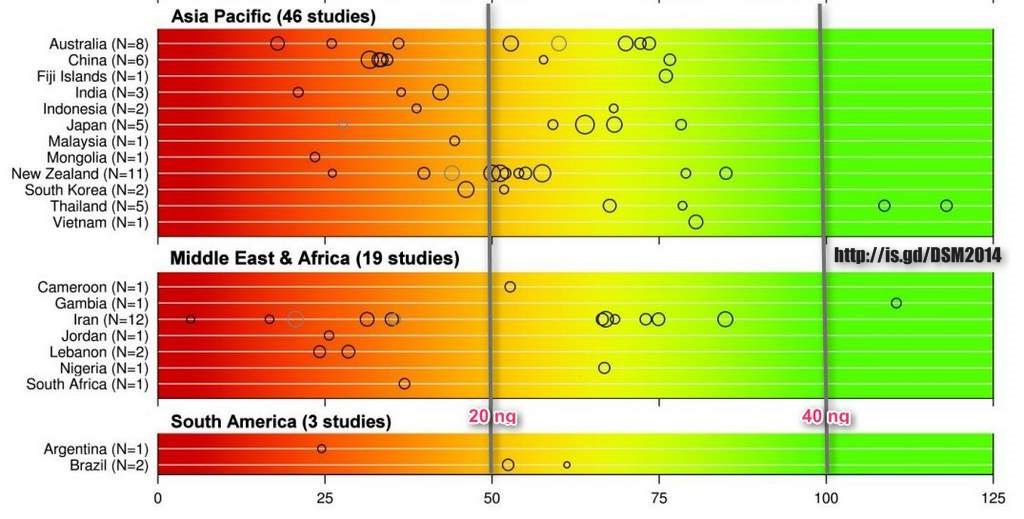Vitamin D deficiency in China – only 1 in 18 have even 30 ng, fewer if young or female
The High Prevalence of Hypovitaminosis D in China: A Multicenter Vitamin D Status Survey.
Medicine (Baltimore). 2015 Feb;94(8):e585.
Yu S1, Fang H, Han J, Cheng X, Xia L, Li S, Liu M, Tao Z, Wang L, Hou L, Qin X, Li P, Zhang R, Su W, Qiu L.
1From the Department of Clinical Laboratory (SY, HF, JH, XC, LX, LH, XQ, PL, WS, LQ), Peking Union Medical College Hospital, Chinese Academy of Medical Sciences, Beijing; Department of Clinical Laboratory (SL), The First Affiliated Hospital of Dalian Medical University, Dalian; Department of Clinical Laboratory (ML), The First Affiliated Hospital, Sun Yat-sen University, Guangdong; Department of Clinical Laboratory (ZT), The Second Affiliated Hospital of Zhejiang University School of Medicine, Hangzhou; Department of Clinical Laboratory (LW), Xinjiang Medical University, Xinjiang; and Department of Clinical Laboratory (RZ), China-Japan Friendship Hospital, Beijing, China.
Vitamin D deficiency, which is usually detected by using immunoassays or the more reliable liquid chromatography tandem mass spectrometry (LC-MS/MS) methods, has recently been considered a public health problem worldwide. However, the vitamin D status in Chinese populations, as measured using the LC-MS/MS method, is not available. The objective of this multicenter study was to determine the vitamin D status and prevalence of vitamin D deficiency by using a reliable method in 5 large cities in China.From May 1 to September 31, 2013, we conducted a multicenter study on 2173 apparently healthy adults who were recruited from 5 Chinese cities. The 25-hydroxyvitamin D 25OHD2 and 25OHD3 levels were measured using the LC-MS/MS method. Intact parathyroid hormone (iPTH), calcium, phosphorus, and alkaline phosphate levels were also measured using an automatic analyzer.The mean 25OHD level of all participants was 19.4 ± 6.4 ng/mL (2.5-97.5%: 7.9-32.6 ng/mL), and only 109 (5.0%) participants had a 25OHD2 level >2.5 ng/mL (maximum, 22.4 ng/mL). In this study, the prevalence of severe vitamin D deficiency (<10 ng/mL), vitamin D deficiency (10-20 ng/mL), vitamin D insufficiency (20-30 ng/mL), and vitamin D sufficiency (>30 ng/mL) was 5.9%, 50.0%, 38.7%, and 5.4%, respectively.
Women had a significant higher rate of deficiency than men (66.3% vs 45.3%, P < 0.01).
Participants aged 18 to 39 years had a lower 25OHD level than elderly individuals (>59 years). Lifestyle may influence the 25OHD level more than the latitude, with participants in Dalian having the highest 25OHD level and the lowest deficiency rate. The serum iPTH level showed a significant negative correlation with the 25OHD level (r = -0.23, P < 0.01) after correcting for age and sex.
In conclusion, the present study evaluated the vitamin D status using a reliable method, and our results indicate that vitamin D deficiency is prevalent among all age groups in China, especially among younger adults. We also observed significant differences in the 25OHD levels according to sex, age, and region among apparently healthy individuals.
Women


📄 Download the PDF from VitaminDWiki
See also VitaminDWiki
Most Chinese have less than 20 ng level of Vitamin D - meta-analysis Aug 2021
2000 IU vitamin D not enough to get most Chinese to 20 ng level – RCT Feb 2015
Beijing extremely vitamin D deficient even in the fall: 10 ng – April 2013
Beijing women have low vitamin D - 89 percent have less than 20 ng - June 2015
NONE of the pregnant Beijing women had adequate levels of vitamin D – April 2013
20 X more Parkinson's and 100X more Autism with GMO soy in China in 20 years
Vitamin D levels in healthy populations around the globe – Aug 2012

click on charts for details
